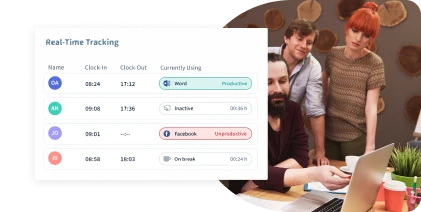Navigating the ever-shifting terrain of human resources comes with its fair share of risks.
Did you know that 78% of HR leaders lack data analytics for strong decision-making?
This is where Workforce Analytics Software steps in as your trusted ally.
This blog post will delve into HR risk management, armed with the power of data, to unveil how such tools can transform your approach.
Buckle up for a journey into a smarter, more resilient HR future!
Let’s dive in:
Challenges in HR Risk Management
Here are some of the major challenges involved in HR risk management:
1. Workforce Planning
Effective workforce planning is like playing chess; you need to strategize for the present and future simultaneously.
The challenge lies in aligning your current workforce with your long-term business goals.
Picture this: As of 2021, 45% of organizations reported struggling with workforce planning.
Workforce analytics software can be your guiding star. It analyzes historical data and predicts future needs.
You can prepare your team to weather any storm by understanding trends and potential skill gaps.
Think of it as your crystal ball for HR.
2. Employee Relations
Employee relations are like tending to a delicate garden. Conflicts, grievances, and misunderstandings can sprout at any time.
In fact, studies suggest that unresolved workplace conflicts cost U.S. companies an estimated $359 billion per year.
Here, Workforce analytics software acts as your peacemaker.It helps you spot brewing issues by analyzing communication patterns and feedback.
Proactive interventions become easier when you have data-driven insights at your fingertips.
Think of it as your mediator in the HR garden.
3. Performance Management
Performance management can be a real juggling act. Balancing individual growth with organizational objectives can be tricky.
Surprisingly, only 20% of employees believe their performance is managed effectively.
Workforce analytics tools step in as your performance magician. It tracks employee progress, identifies top performers, and suggests areas for improvement.
This boosts individual growth and propels the organization towards its goals.
Think of it as your wand for HR excellence.
An HR manager, Emily, used Workstatus to track leaves, absences, and workforce performance to make data-driven decisions in a more engaged and productive workplace.
4. Recruitment and Retention
Recruitment and retention are like a seesaw; finding the right talent while keeping your existing stars happy is a constant challenge.
Did you know it costs an average of 33% of an employee’s annual salary to replace them?
Workforce analytics can be your talent magnet. It scours data to pinpoint the best recruitment sources and predicts who might be considering jumping ship.
With this information, you can craft retention strategies that keep your team intact and thriving.
Think of it as your magnet for HR success.
Understanding Workforce Analytics Software
Imagine having a wise assistant for your HR tasks. Workforce Analytics Software does just that.
It uses data to reveal insights about your employees, helping you make smarter decisions, identify potential issues, and enhance your team’s performance.
It’s like having a trusted advisor in the world of HR.
1. Absenteeism Rate
The absenteeism rate is like counting how often employees miss work.
When many employees are absent, it might signal a problem, like people not feeling good about their jobs.
Tracking this rate helps HR know if they need to fix something.
Here’s how Workstatus can help you:
Automatic clock-in and clock-out: Workstatus allows employees to log their work hours accurately, including breaks and time off.
Geofencing: It enables employers to set up geographical boundaries, ensuring field employees work from the specified locations.
Schedules: Managers can create and monitor work schedules, making it easier to spot deviations in attendance.
2. Task Completion Rates
Task completion rates tell us how well tasks and projects are getting finished.
It’s like checking if everyone’s doing their homework.
If tasks are often left undone, it can slow things down. HR can use this info to keep work running smoothly.
Here’s how Workstatus can help you:
Task Tracking: Workstatus offers task management features that let you assign tasks to team members and track their progress.
Custom Filters: Tailor your analysis with custom filters. Focus on specific projects, teams, or timeframes to extract meaningful insights.
Data Visualization: Visualize your work and progress with interactive charts and graphs.
Sarah, a customer service supervisor, used real-time reporting tools of Workstatus to identify areas for improvement, provide timely feedback to her agents, and enhance customer satisfaction.
3. Employee Engagement
Employee engagement is like checking if people are happy at work.
When teams are engaged, they’re more likely to do their best work. HR can use surveys and feedback to see how employees feel and make improvements.
Here’s how Workstatus can help you:
Screenshots: You can capture screenshots of employees’ screens at random intervals to ensure they are actively working on assigned tasks.
Activity Rates: Workstatus provides employee activity rates during work hours, helping you gauge productivity.
Activity Insights: By analyzing activity data, you can identify signs of disengagement, such as decreased activity levels or frequent breaks.
4. Productivity Trends
Productivity trends show how much work is getting done over time.
It’s like keeping an eye on how fast a car is going.
HR can use this to spot if work is slowing down; if it is, they can find ways to speed it up.
Here’s how Workstatus can help you:
Historical Data: Access historical data to identify trends and patterns. Make data-backed decisions based on past performance.
Custom Analytics: Create tailored reports and dashboards to track your project KPIs.
Automated Reporting: Download visual reports on time & activity, attendance, productivity, and more with just a few clicks
5. Resource Allocation
Resource allocation means using your team in the best way possible. It’s like ensuring you have the right players in the right positions in a sports team.
HR can use data to determine who should do what to avoid overloading or underusing employees.
Resource Management: Allocate specific tasks to team members, ensuring resources are used efficiently.
Workload Balancing: Monitor individual workloads to make data-driven decisions about workload distribution and avoid overloading or underusing employees.
6. Workplace Communication
Workplace communication is about how well people talk and share ideas at work.
It’s like making sure everyone is on the same page. HR can use tools to help teams communicate better and reduce misunderstandings.
Good communication keeps things running smoothly.By tracking these metrics and using tools like Workstatus, HR can ensure employees are happy, work is done efficiently, and the workplace is a well-oiled machine.
Future Trends in HR Risk Management
HR risk management is evolving to meet the dynamic challenges of the modern workforce and the ever-changing business landscape.
Here are some future trends in HR risk management:
- AI-Powered Predictive Analytics: HR increasingly uses artificial intelligence (AI) and predictive analytics to forecast potential risks. It can analyze past data to predict future HR issues, such as turnover or absenteeism, allowing HR teams to take proactive measures.
- Cybersecurity and Data Protection: As HR relies more on technology for data management, protecting employee data becomes a critical HR risk. Future trends include enhanced cybersecurity measures, data encryption, and compliance with evolving data protection regulations like GDPR and CCPA.
- Remote Work Risks: With the rise of remote and hybrid work arrangements, HR faces new challenges related to employee productivity, engagement, and mental health in virtual environments. HR risk management will focus on strategies to address these issues and maintain effective remote workforces.
- Diversity, Equity, and Inclusion (DEI) Risks: DEI initiatives are gaining prominence, and HR must manage risks related to discrimination, bias, and inclusivity. Future trends will involve using technology to monitor and promote organizational diversity and inclusion.
- Mental Health and Well-being: Employees’ mental health is becoming a top priority. HR must focus on identifying and mitigating stress, burnout, and mental health risks through employee assistance programs and support networks.
A project manager, John relied on Workstatus to manage his team’s schedules, tasks, and project progress. He experienced a 21% reduction in scheduling conflicts and delays.
Closing Thoughts
Workforce Analytics Software is the key to tackling HR challenges effectively.
Using data insights, HR can make better decisions in workforce planning, employee relations, performance management, recruitment, and communication.
A Workforce analytics tool like Workstatus can empower HR to adapt and thrive in the ever-changing business world.
FAQs
Ques: What is Workstatus, and how can it benefit my business?
Ans: Workstatus is workforce analytics software that helps you monitor employee productivity, track work hours, manage tasks, and improve team collaboration. It benefits your business by enhancing efficiency, streamlining operations, and providing valuable insights for data-driven decision-making.
Ques: Can Workstatus help with remote team management?
Ans: Yes, Workstatus is excellent for remote team management. It offers features like time tracking, task assignment, and activity monitoring, enabling you to effectively manage and collaborate with remote employees.
Ques: Is Workstatus suitable for small businesses?
Ans: Absolutely, Workstatus is suitable for businesses of all sizes. It’s scalable and customizable, making it an ideal solution for small businesses looking to streamline their workforce management and improve productivity.



















